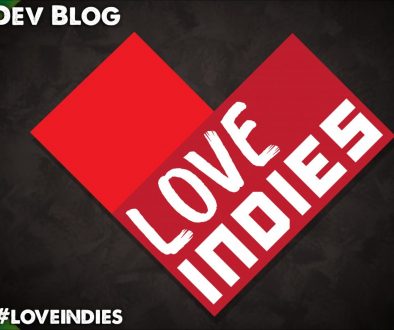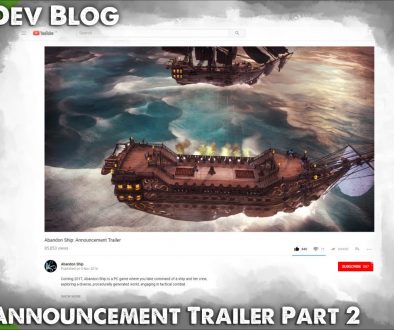Our Announcement Trailer was one of the biggest moments in the development of Abandon Ship. It was a culmination of several months of hard work and ultimately a validation of what we were working towards – an awesome game that people cared about. As we approach the one year anniversary of its release, this two-part series of Dev Blogs looks back at the development process of this trailer and a post-mortem of its success.
First, it’ll be good to refresh your memory of the final version of the trailer:
Now we’ve re-watched it, let’s see how it came about…
I left my previous job in November 2015 with an intention of “going Indie” and to develop my own game. I had some vague ideas of what I wanted to create, but at this stage, it was only me on the team. The company hadn’t even been formed yet.
I had a rough plan of 6 weeks of experimenting in the engine, designing the Core Pillars of the game and analysing the competition in order to find my feet. This would take me to January 2016, where I would start “for real”.
During that time, my mind was racing through a million possibilities, and I found myself thinking about what our Announcement Trailer could be. Normally in development, you wouldn’t think about trailers so early, however it started to help crystallise my thoughts on the rest of the game so fed back into the early design.
Competitive Analysis & High-Level Treatment
As this was bringing real value to the rest of this early-stage development, I started to think about the trailer more seriously. I began looking at other trailers and writing down how many views they had, their length, what I felt was successful and what wasn’t, among other useful information. I did this for games that had a similar theme, mechanics, were memorable or recently released.
While I felt slightly guilty about doing this – after all, I’d just left my “proper job” and I’m spending the day watching trailers, this awareness of what other people in the industry are doing is important. It helps frame your ideas and there are lessons to be learned that could help you avoid mistakes in the future.
I didn’t want our announcement trailer to be a simple list of features along with footage of gameplay. I knew how hard it would be to get noticed and there would not be many occasions to engage with the press so it was a real opportunity to stand out and make our mark.
I commenced writing several high-level treatments for what the trailer could be. Each treatment took the format of a single sentence with 3-4 bullet points explaining the idea. I had written a few and immediately one stood out:
This immediately stood out to me and I kept coming back to it. While I could have invested more time coming up with other ideas I made the decision to press on with this one.
The Beats
When creating a story, writers will spend a long time on “The Beats”. These are a list of key story points that gets moved around and fleshed out until the story makes sense, has a strong start, middle and end and has no major plot-holes.
As our chosen high-level treatment had a narrative element to it, writing the key points in Beat format felt like a good way to knock the trailer into shape.
This started off with a list of game features I wanted to show in the trailer that would encapsulate the Abandon Ship experience:
With this in place, I started to create the beats and build up a picture of what the trailer would look like.
Over time, the idea started to take shape. There would be a ship and crew gradually being worn down by all these terrible events (which were gameplay mechanics). This would culminate in the ship being destroyed – normally ‘Game Over’ in similar games – but not in Abandon Ship. This was a key point to get across to the viewer – that ship destruction was not necessarily the end, that you can come back and triumph – which would be shown in a final scene, ending the trailer on a high note after it looked like all was lost. This neatly tied in with a core pillar of the game – a feeling of “snatching victory from the jaws of defeat”.
The beats were iterated multiple times into the following:
Looking back, it’s interesting to see how even at this early stage (about a month since I started) a lot of gameplay ideas were already in place that would make it into the final game.This was the final beats spreadsheet before I started creating a draft of the trailer. There were a lot – dozens, maybe – of revisions to get it to this stage, but I felt that this showed everything I wanted. The dialogue was only written once I felt the beats were locked down.
It was at this point that I felt ready to create an extremely rough draft of the trailer.
It is beneficial if this process is not something you do in a solid block from start to finish. I would spend an afternoon working on the trailer and come back to it several days later and kept doing this until I felt it was in the right place. The time spent on other aspects is useful because ideas percolate in the back of your mind and help flesh out your thoughts. The entire process from start to the very first rough draft took about a month.
Rough Edit
A rough edit is important because the pacing is difficult to envisage in beats format, and other problems can surface once you have something to watch and listen to. It may even force you back to the beats to fix problems before returning to a new edit.
By this time, my work on Abandon Ship had been a combination of paper designs and messing about in the engine. It meant I had some screenshots of simple prototype gameplay that I could combine with static images and freely available sound effects to create an edit of the trailer. It wouldn’t look pretty, but it would prove out the work thus far.
I am no artist – so naturally everything is placeholder – and at this stage, so it should be. I share this video knowing that other indie developers follow this blog and find these tips useful, and fans of the game find it interesting to see ‘behind the scenes’ and where the game has come from:
This video is unlisted (i.e. not public) and on my personal YouTube account. It is only meant for consumption by readers of this blog post. See YouTube video description for full disclaimer.
Please excuse the placeholder images, there were no artists on the team – Fireblade Software wouldn’t even be registered for several more weeks – and the game was originally envisaged as top-down!
Look past the visuals though and it did achieve what I wanted it to. It proved the beats. It told a story. Tonally it achieved the right vibe I was aiming for. It showcased the right mechanics. Excluding the lovely art, it isn’t that far from what the final trailer became. This draft gave me faith the foundations were in place for a great announcement.
Other “Directors Commentary” style notes:
– Music was very important for setting the right mood. As I didn’t have an Audio Designer on the team I used an existing piece of music that I felt was a good tonal fit. This is quite a common practice in the industry
– The voice-over was done by me. At this stage, no need to hire a professional voice-actor.
– 0:13 – A glimpse of the original prototype top-down exploration gameplay
– 0:31 – a message box within a picture frame. While this wouldn’t be used for the in-game messages, it would ultimately border our exploration maps.
– 0:35 – Rain, Lightning, Tidal Waves and Brace for Impact – all mechanics that would make it into the final game were already thought of, even a month into development
– 0:50 – Man overboard plus shark-infested waters. The latter hasn’t made it into the game so far because in its current form it doesn’t bring huge gameplay value. I’d still like to squeeze this in, even if it’s a post-release addition.
– 0:54 – You can hear my awesome “death gurgle” here 🙂
– 0:56 – Sea Forts. Although these aren’t in the game, I would love to add them back in at a later date, even if it was post-release.
– 1:04 – Visuals aside, the Kraken scene translated perfectly into the final trailer
– 1:14 – The fog combat was a good example of why we ultimately moved away from a top-down view. We wanted to have ship distance as a factor in combat, and we couldn’t pull the camera too far back otherwise it was too hard to control the crew, so we had a screen divider instead. However this wasn’t working well enough, so in early 2016 one of the first things we did was start experimenting with a different camera, which ultimately led to the existing gameplay.
– 1:46 – I added the drifting bottle here as a call back to the opening scene in the trailer.
– 1:58 – Mortars, Grapeshot, Harpoons, Ramming and Boarding are all mechanics seen here that play a large part in the combat gameplay in the final game.
– 2:21 – I needed a logo at the end and wasn’t planning on creating one properly for a while, so I threw this together. If you’re interested in our logo development you should read this blog post (click here to read about our Logo Development).
– 2:24 – “Coming Early 2017”. Yeah, that didn’t happen. I’ll cut myself some slack here – I’d only been working on the game for a month and had barely started. It was a wild guess based on a rough plan at the time.
While there were a few minor edits I wanted to make, I parked the trailer work. I’d done enough on it for now. January 2016 was looming, and with it, the start of what I had previously dubbed “the real work” was due to commence.
It was a valuable exercise though. Not only because it really helped focus my work in other areas, but also because it had laid solid foundations for what would ultimately become our final announcement trailer.
I hope you enjoyed this post. In the follow-up part, we’ll dive forward several months – a full team will be in place, and my thoughts would turn back to the trailer that would officially announce our existence to the world.







